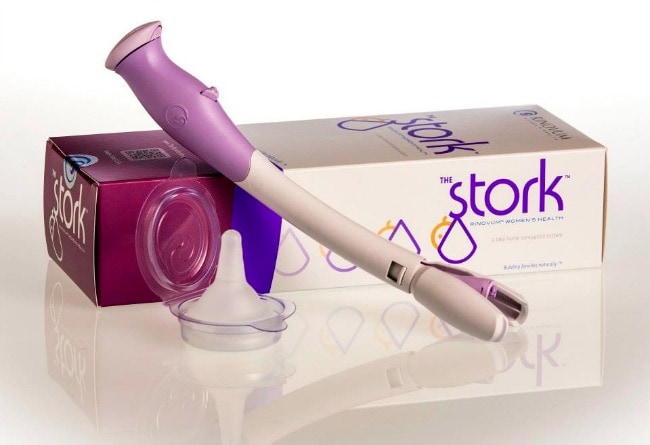If you follow me over on BabyZone, you've seen that Nate and I have tried a whole host of weird things to get pregnant with a third child. At home fertility treatment options range from the awkward (charting) to the questionable (cough syrup) to the downright gross (cod liver oil).
After trying to conceive for over a year and getting well-entrenched in the world of at home fertility treatment options, I was excited to see a new option come onto the scene. Called The Stork, it's perfect for couples like us who don't want to deal with expensive and invasive doctor's office procedures but are ready to take things into their own hands with at home fertility treatment.
The Stork for At Home Fertility Treatment
This tool takes the idea behind a popular medical intervention method – assisted insemination – and lets couples take control in the comfort of their own bedroom. It gathers semen into a cervical cap via a condom-like sheath (through natural intercourse) and helps deliver it right outside the cervix with a tampon-like applicator.
I had a chance to speak with Steve Bollinger, CEO and Founder of the company, and was impressed with his deep understanding of at home fertility issues. He and his wife had a personal struggle with infertility, and he expressed concern over the rapidly rising rates of infertility around the globe. I asked him some common questions that I thought may come up about the product, and here's what he had to share:
- The Stork should be introduced as soon as couples decide that they are trying to conceive, as it will greatly increase chances and decrease the waiting period.
- It is currently available with a prescription from any medical provider, which is then submitted on The Stork website for fulfillment. By Fall 2014, it is expected to be available at CVS and on Amazon without a prescription.
- It does work with “tipped” or anti-verted uteruses and gives a benefit of combatting semen “pooling” that tends to be a concern with slanted uteruses.
- The Stork typically works within four or five attempts over five months. It is very well-suited to older couples, people with low sperm motility, hostile vaginal environment and even young couples with schedule constraints trying to maximize their time together.
- The Stork is made of implantable-grade silicone, the least reactive material which is also used for body implants.
- The cap is intended to be left in place for six hours. Leaving the cervical cap in longer does not equal better results. It can be left in overnight while you sleep.
The Stork is available for $79 and is not covered by most insurance, putting it in a very price-friendly range for couples seeking at home fertility treatment.
Have you ever tried any at home fertility treatment options?

